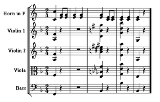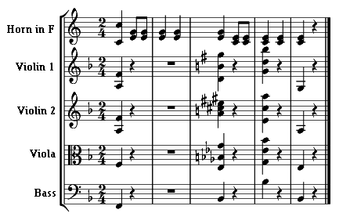
A Musical Joke
Encyclopedia
A Musical Joke K. 522, (Divertimento
for two horns and string quartet) is a composition by Wolfgang Amadeus Mozart
; the composer entered it in his Verzeichnis aller meiner Werke ('Catalogue of all my Works') on June 14, 1787. The music is intentionally written to be funny, being liberally sprinkled with obtrusively clumsy, mechanical and over-repetitive composition, together with passages evidently designed to mimic the effects of inaccurate notation and inept performance. Commentators have opined that the piece's purpose is satirical—that "[its] harmonic and rhythmic gaffes serve to parody the work of incompetent composers" -- though Mozart himself is not known to have revealed his actual intentions.
Nevertheless, the music has potential to appeal to the average audience of that time as a comedy, including:
The piece is also notable for the earliest known use of polytonality
, creating the gesture of complete collapse with which the finale ends. This may be intended to produce the impression of grossly out-of-tune string playing, since the horns alone conclude in the movement's tonic key: the lower strings behave as if the tonic has suddenly become B flat, while the violins and violas switch to G major, A major and E flat major respectively:
 Some theorists believe that A Musical Joke is a parody of works by clumsy composers of Mozart's time. With such an assumption, one might find some points of the score humorous, such as the more elementary developments of the theme, where the poor composer might feel the agony that he/she had to proceed with the development. Other theorists disagree with that view, saying that perhaps Mozart used parody and comedy as an excuse to try things that at the time were not in practice; the piece would then be intended in a more serious tone than so advertised but only for the composer himself.
Some theorists believe that A Musical Joke is a parody of works by clumsy composers of Mozart's time. With such an assumption, one might find some points of the score humorous, such as the more elementary developments of the theme, where the poor composer might feel the agony that he/she had to proceed with the development. Other theorists disagree with that view, saying that perhaps Mozart used parody and comedy as an excuse to try things that at the time were not in practice; the piece would then be intended in a more serious tone than so advertised but only for the composer himself.
The use of asymmetrical phrasing, whole-tone scales, and multitonality is quite foreign to music of the classical era
. However, these techniques were later revisited by early 20th century composers like Claude Debussy
and Igor Stravinsky
, who were searching for a new musical language. In this later context, these conventions were seen as legitimate new techniques in serious music. In Mozart's time, however, these non-classical elements give the piece its comedy and express the composer's sense of musical humor.
Remarkably, A Musical Joke is the first piece entered in Mozart's list of works following the death of his father Leopold
on May 28.
pointed out, 'Spaß' does not strongly connote the jocular—for which the word 'Scherz' would normally be required. In Spiegl's view, a more accurate translation would have been Some Musical Fun.
Perpetuum mobile
: Ein musikalischer Scherz op. 257, a polka
by Johann Strauss II
is likewise (and more correctly) translated as A Musical Joke.
, the opening of the finale of A Musical Joke was used for many years as the theme tune to the BBC
's Horse of the Year Show
.
Divertimento
Divertimento is a musical genre, with most of its examples from the 18th century. The mood of the divertimento is most often lighthearted and it is generally composed for a small ensemble....
for two horns and string quartet) is a composition by Wolfgang Amadeus Mozart
Wolfgang Amadeus Mozart
Wolfgang Amadeus Mozart , baptismal name Johannes Chrysostomus Wolfgangus Theophilus Mozart , was a prolific and influential composer of the Classical era. He composed over 600 works, many acknowledged as pinnacles of symphonic, concertante, chamber, piano, operatic, and choral music...
; the composer entered it in his Verzeichnis aller meiner Werke ('Catalogue of all my Works') on June 14, 1787. The music is intentionally written to be funny, being liberally sprinkled with obtrusively clumsy, mechanical and over-repetitive composition, together with passages evidently designed to mimic the effects of inaccurate notation and inept performance. Commentators have opined that the piece's purpose is satirical—that "[its] harmonic and rhythmic gaffes serve to parody the work of incompetent composers" -- though Mozart himself is not known to have revealed his actual intentions.
Structure and Intention
The piece consists of four movements, using forms shared with many other classical divertimenti:- Allegro. (In sonata formSonata formSonata form is a large-scale musical structure used widely since the middle of the 18th century . While it is typically used in the first movement of multi-movement pieces, it is sometimes used in subsequent movements as well—particularly the final movement...
) - Menuetto and Trio.
- Adagio cantabile.
- Presto. (Sonata rondo formSonata rondo formSonata rondo form was a form of musical organization often used during the Classical music era. As the name implies, it is a blend of sonata form and rondo form.- Structure :...
)
Nevertheless, the music has potential to appeal to the average audience of that time as a comedy, including:
- use of asymmetrical phrasing, or not phrasing by four measure groups, at the beginning of the first movement, which is very uncommon for the classical period,
- use of secondary dominantSecondary dominantSecondary dominant is an analytical label for a specific harmonic device, prevalent in the tonal idiom of Western music beginning in the common practice period...
s where subdominantSubdominantIn music, the subdominant is the technical name for the fourth tonal degree of the diatonic scale. It is so called because it is the same distance "below" the tonic as the dominant is above the tonic - in other words, the tonic is the dominant of the subdominant. It is also the note immediately...
chords are just fair, - the use of discords in the French horns, satirizing the incompetence of the copyist, or the hornist grabbing the wrong crookCrook (music)A crook, also sometimes called a shank, is an exchangeable segment of tubing in a natural horn which is used to change the length of the pipe, altering the fundamental pitch and harmonic series which the instrument can sound, and thus the key in which it plays.-Master crook and coupler...
, - use of a whole tone scaleWhole tone scaleIn music, a whole tone scale is a scale in which each note is separated from its neighbors by the interval of a whole step. There are only two complementary whole tone scales, both six-note or hexatonic scales:...
in the violinist's high register, probably to imitate the player's floundering at the high positions.
The piece is also notable for the earliest known use of polytonality
Polytonality
The musical use of more than one key simultaneously is polytonality . Bitonality is the use of only two different keys at the same time...
, creating the gesture of complete collapse with which the finale ends. This may be intended to produce the impression of grossly out-of-tune string playing, since the horns alone conclude in the movement's tonic key: the lower strings behave as if the tonic has suddenly become B flat, while the violins and violas switch to G major, A major and E flat major respectively:

The use of asymmetrical phrasing, whole-tone scales, and multitonality is quite foreign to music of the classical era
Classical period (music)
The dates of the Classical Period in Western music are generally accepted as being between about 1750 and 1830. However, the term classical music is used colloquially to describe a variety of Western musical styles from the ninth century to the present, and especially from the sixteenth or...
. However, these techniques were later revisited by early 20th century composers like Claude Debussy
Claude Debussy
Claude-Achille Debussy was a French composer. Along with Maurice Ravel, he was one of the most prominent figures working within the field of impressionist music, though he himself intensely disliked the term when applied to his compositions...
and Igor Stravinsky
Igor Stravinsky
Igor Fyodorovich Stravinsky ; 6 April 1971) was a Russian, later naturalized French, and then naturalized American composer, pianist, and conductor....
, who were searching for a new musical language. In this later context, these conventions were seen as legitimate new techniques in serious music. In Mozart's time, however, these non-classical elements give the piece its comedy and express the composer's sense of musical humor.
Remarkably, A Musical Joke is the first piece entered in Mozart's list of works following the death of his father Leopold
Leopold Mozart
Johann Georg Leopold Mozart was a German composer, conductor, teacher, and violinist. Mozart is best known today as the father and teacher of Wolfgang Amadeus Mozart, and for his violin textbook Versuch einer gründlichen Violinschule.-Childhood and student years:He was born in Augsburg, son of...
on May 28.
Issues of Translation
The established English title A Musical Joke is a poor rendering of the German original: as Fritz SpieglFritz Spiegl
Fritz Spiegl was born at Zurndorf, Austria, the son of an agricultural merchant and his Jewish wife. He became a musician, journalist, broadcaster, humorist and collector who lived and worked in England from 1939....
pointed out, 'Spaß' does not strongly connote the jocular—for which the word 'Scherz' would normally be required. In Spiegl's view, a more accurate translation would have been Some Musical Fun.
Perpetuum mobile
Perpetuum mobile
Perpetuum mobile , moto perpetuo , mouvement perpétuel , movimiento perpetuo , literally meaning "perpetual motion", means two distinct things:#pieces of music, or parts of pieces, characterised by a continuous steady stream of notes, usually at a...
: Ein musikalischer Scherz op. 257, a polka
Polka
The polka is a Central European dance and also a genre of dance music familiar throughout Europe and the Americas. It originated in the middle of the 19th century in Bohemia...
by Johann Strauss II
Johann Strauss II
Johann Strauss II , also known as Johann Baptist Strauss or Johann Strauss, Jr., the Younger, or the Son , was an Austrian composer of light music, particularly dance music and operettas. He composed over 500 waltzes, polkas, quadrilles, and other types of dance music, as well as several operettas...
is likewise (and more correctly) translated as A Musical Joke.
Other uses
In a modernised version by Waldo de los RiosWaldo de los Rios
Waldo de los Ríos was an Argentine composer, conductor and arranger.De los Rios was born as Osvaldo Nicholas Ferrara in Buenos Aires into a musical family; his father was a musician and his mother a well known folk singer; he studied composition and arranging at the National Conservatory of Music...
, the opening of the finale of A Musical Joke was used for many years as the theme tune to the BBC
BBC
The British Broadcasting Corporation is a British public service broadcaster. Its headquarters is at Broadcasting House in the City of Westminster, London. It is the largest broadcaster in the world, with about 23,000 staff...
's Horse of the Year Show
Horse of the Year Show
The Horse of the Year Show - also known as HOYS - was founded to be a culmination of the British equestrian events year. Because of this, the show needed to be held indoors, making it a unique event....
.

